First quantum computer to be unveiled in 2025 TU Braunschweig significantly involved with quantum and nanotechnologies
The first prototypes of a quantum computer are already being tested in the Hannover-Braunschweig region and are being developed further at a rapid pace. By 2025, the first quantum computer in the country will be put into operation in close cooperation between research and industry. Over the next 10 years, more than 1.5 billion euros are to be invested in this future field. During a press tour with Lower Saxony’s Minister of Science Björn Thümler, the results to date and the forward-looking plans of the Quantum Valley Lower Saxony initiative were presented. The Technische Universität Braunschweig is part of the nucleus of the alliance with its research focus on metrology, the Cluster of Excellence QuantumFrontiers and the Research Center for Nanometrology “LENA”. The focus of the TU Braunschweig here is on quantum and nanotechnologies as well as the miniaturization and parallelization of quantum processors. Within the scope of the tour, application-oriented opportunities of use of the TU Braunschweig were presented.
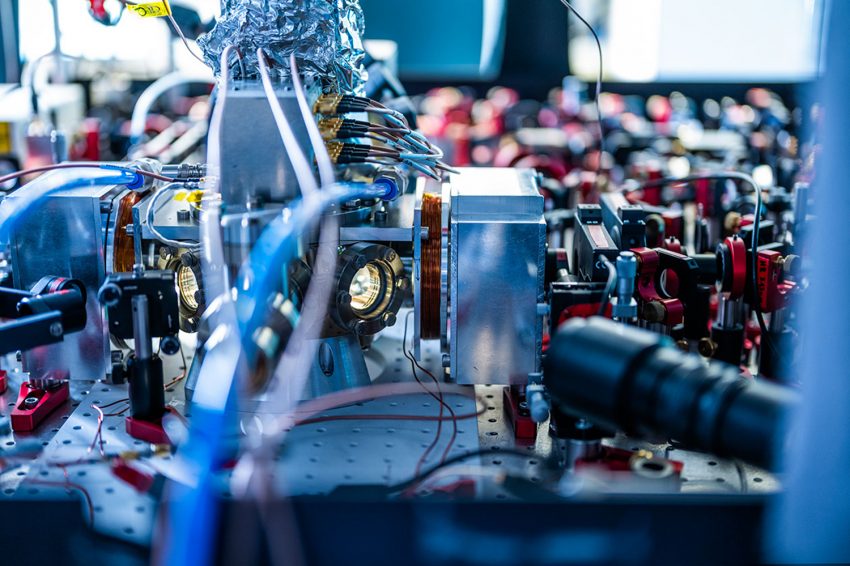
The heart of a quantum computer prototype in Braunschweig. Pictured are optical components for controlling laser light to control individual ions in an ion trap processor. Image credit: QVLS
Quantum computers are considered one of the most promising technological breakthroughs of the 21st century. Germany is in the global race and is investing up to 2 billion euros in this future field nationwide by 2025 as part of the Corona stimulus package. One of the leading national ecosystems for building quantum computers and for quantum metrology is being created in Lower Saxony. Here, federal funding will be supplemented by other sources from research and, in particular, by commitment from industry, and quantum breakthroughs will be driven forward in this decade with a projected total volume of over 1.5 billion euros. The QVLS strategic roadmap includes further development of ion trap technology, large-scale projects with companies, commercialization of spin-off innovations, start-up funding, quantum education, and several new research buildings.
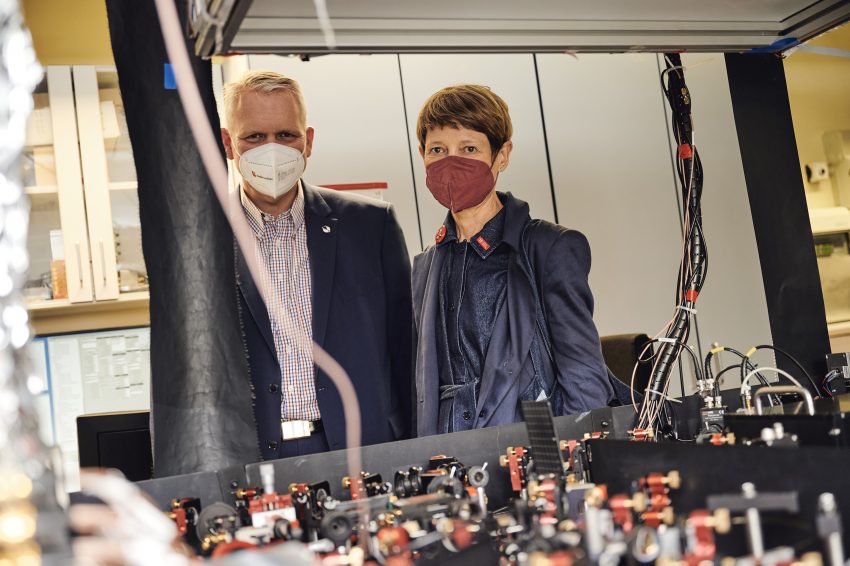
Minister Björn Thümler und Präsidentin Prof.in Angela Ittel vor dem Prototypen des Quantencomputers an der PTB. Bildnachweis: QVLS
With ion trap technology, the researchers are using one of the most promising approaches currently available to develop scalable quantum computers. Bringing together all the necessary expertise under one roof – from nanotechnology to quantum algorithms or the production of ion trap chips – is a convincing unique selling point of the alliance in Germany and in Europe. However, the goal of the Quantum Valley Lower Saxony state initiative is not only to further expand its leading role in research. With its own office, which began operations on January 1, 2021, the involvement of industry and, in particular, technology transfer and the start-up scene are also to receive a powerful boost. Both basic research and industrial value creation are the prerequisites for achieving top positions in quantum technologies and, in particular, in quantum computing.
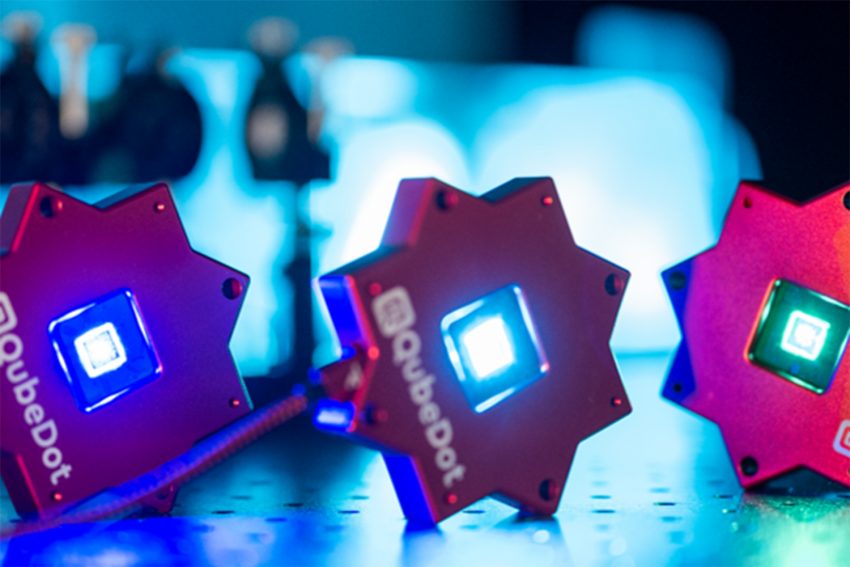
Demonstrators for microLED arrays for structured illumination with different wavelengths, that is, in different colors. Image credit: QVLS
Presentation of basic technologies for spillover applications of TU Braunschweig
A microscope for your pocket
For a highly integrated quantum computer in ion trap architecture, basic technologies have to be developed that already radiate to other fields of application. To miniaturize quantum processors, scientists are developing highly integrated light sources such as lasers or microLEDs. These enable targeted illumination on the nanoscale (SMILE = Structured Micro Illumination Light Engine), which is particularly interesting for applications in the life sciences. These were presented by Prof. Dr. Stefanie Kroker and Dr. Jana Hartmann. SMILE modules can optically stimulate nerve cells, for example, and replace the time-consuming installation of electrodes. MicroLEDs are also the basis for a completely new type of microscopy: chip microscopy without optical elements, lenses, objectives or mechanical traversing devices. Their robust and compact design allows them to be used directly on site. The possible applications of such super-compact microscopes are extremely diverse and ultimately stem from the development of quantum technologies. The leap from research to market is being accompanied by QubeDot GmbH, a young start-up of the QVLS initiative and a spin-off of the Institute of Semiconductor Technology. Here, Jan Gülink presented a MicroLED array that can be used directly on site by tests on water and food quality.
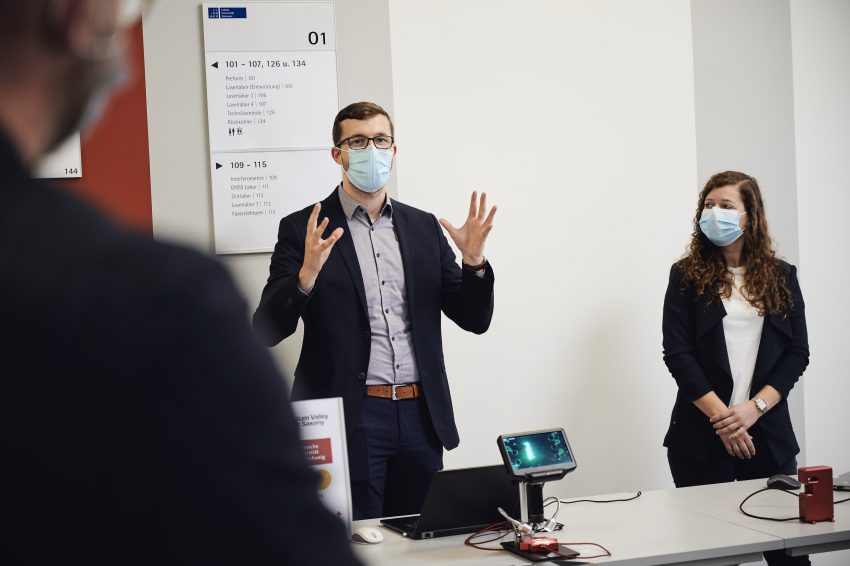
Dr. Jana Hartmann and Jan Gülink present possible applications for super-compact chip microscopy, among other things, on the tour. Image credit: Moritz Küstner/QVLS
Quantum sensors for novel, quantitative rapid test for the SARS-CoV-2 virus
The Corona pandemic is still keeping the world on tenterhooks. Right now, the fourth wave of infections is building up in Germany. For rapid and especially reliable detection of infected individuals, the available rapid antigen tests must be qualified and their sensitivity and specificity verified. Professor Meinhard Schilling, Institute of Electrical Measurement Science and Fundamental Electrical Engineering, presented superconducting SQUID quantum sensors for the detection of magnetic nanoparticles, on which the institute has been researching for some time. They are also used in the new rapid test device he presented for detecting the corona virus SARS-CoV-2. This novel, highly sensitive and rapid method for detecting Covid infection has already been successfully tested on samples from Corona patients from the Braunschweig Municipal Hospital. Quantitative viral load measurements with high reproducibility can be performed in minutes.
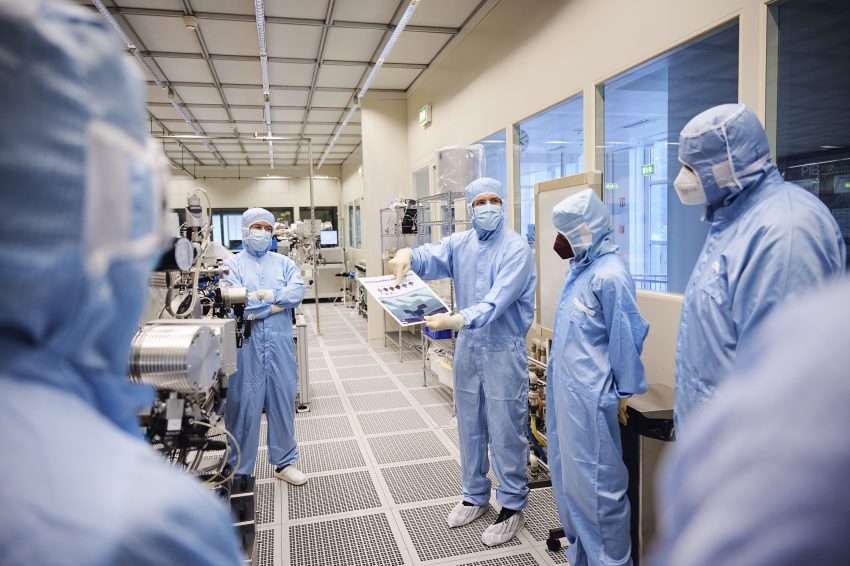
The tour also went through PTB’s clean room center. Here, all the equipment and processing capabilities required for microfabrication processes are available. Photo credit: Moritz Küstner/QVLS
Voices
Björn Thümler, Lower Saxony Minister for Science and Culture: “With Quantum Valley Lower Saxony, we are deliberately focusing on a key technology of tomorrow. In the course of the digital transformation, science and industry are increasingly dependent on computing capacities that are expected to perform ever more complex computing operations in ever shorter periods of time. As one of two locations of the North German Supercomputing Alliance, Lower Saxony has already experienced how important these capacities are. And the more important artificial intelligence becomes for business, science and society, the more these requirements are likely to increase. With quantum technology, we are probably entering completely new dimensions – presumably because at the present time we have only a rough idea of the disruptive potential of quantum technology. Lower Saxony is currently a step ahead in quantum technology. With the help of QVLS, science fiction should become science facts.”
Professor Dr. Angela Ittel, President of TU Braunschweig: “The Lower Saxony Quantum Alliance is a great example of joint and holistic excellence ‘made in Lower Saxony’. We are proud that we at TU Braunschweig can contribute our outstanding expertise in nano- and quantum technology to jointly develop a quantum computer that is unique worldwide. At TU Braunschweig, we are conducting research at the highest level on the scalability of the supercomputer to make it as small and compact as possible, yet enormously powerful and energy-efficient.”
Background
Leading research institutions, companies and the state of Lower Saxony joined forces in October last year to form the Quantum Valley Lower Saxony (QVLS) alliance in order to pool the expertise of more than 400 scientists at the participating institutions. 50 of these researchers come from the TU Braunschweig. In addition to the projects and investments of more than 220 million euros in recent years, the state of Lower Saxony and the Volkswagen Foundation provided the initiative with 25 million euros in December 2020 as core funding for the construction of a quantum computer. This sum is to be multiplied as part of the federal tenders currently underway and will further accelerate technological development.
